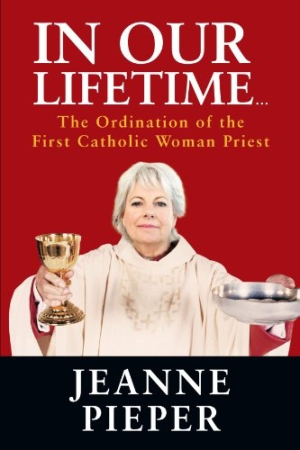In Our Lifetime...
The Ordination of the First Catholic Woman Priest
“It wasn’t me giving her absolution, it was God. He moved my hand. I swear it! He made the words come out of my mouth.” Maureen, a rebellious nun who has left her order, believes she may have been chosen by God to act as a priest, a role the all-male Roman Catholic hierarchy does not extend to women. In Our Lifetime… is a novel written to cast light on an issue that plagues the church, both from without and within.
Author Jeanne Pieper is a freelance writer, community activist, and devout Catholic. As did many others in the 1970s and 1980s, she sincerely believed that ordination for women was just around the corner, but her hopes were dashed when, in 1994, Pope John Paul II made it clear that this was not going to happen. Pieper has written a nonfiction book, The Catholic Woman, which touches on the same subject. In Our Lifetime… is her first novel.
The story centers around the thorny question of a woman’s ordination through the feelings and experiences of three characters—a nun, a bishop, and a housewife. Maureen Connally is a thoughtful nun with leadership potential who is guided toward life outside her convent after the death of one of her sisters, Mary Anne. After she leaves her order, Maureen finds acceptance and the possibility of a loving relationship with a man. Bishop John O’Malley falls afoul of the church’s dictates during Mary Anne’s last celebration, at which the sacraments are administered by and among women—an outrage to church leaders in Rome exacerbated when photographs of the event appear in a tabloid paper. Linda Bonn, Maureen’s cousin, is a faithful wife and mother whose husband expects her absolute obedience.
Pieper’s plot is tidily constructed, with believable characters who grow through adversity. O’Malley is a bit of a “man for all seasons” until he decides to follow his conscience; Linda is “just a housewife” until she tastes a chance for self-fulfillment; Maureen is dedicated to her faith but frustrated by the coldness of the church she loves, until she sees it from the outside. Pieper skillfully weaves their interactions into an ever more complex tapestry as the novel builds toward its climax. Throughout the story, the reader is reminded of the ways that the Vatican deals with those in disfavor: cajoling, mandating, and through subterfuge. One senses the author’s familiarity with those strategies, indicating she has done diligent research in this area. The inner doubts that each character suffers seem especially personal; the Catholic reader in particular will identify with the three main characters as they search for the best way forward, with or without the church.
With its tight plot and credible characterizations, Pieper’s book reads much like the work of a seasoned fiction writer. However, it will be of interest mainly to a rather small group of readers who are directly involved in the issues it addresses.
Reviewed by
Barbara Bamberger Scott
Disclosure: This article is not an endorsement, but a review. The publisher of this book provided free copies of the book and paid a small fee to have their book reviewed by a professional reviewer. Foreword Reviews and Clarion Reviews make no guarantee that the publisher will receive a positive review. Foreword Magazine, Inc. is disclosing this in accordance with the Federal Trade Commission’s 16 CFR, Part 255.

